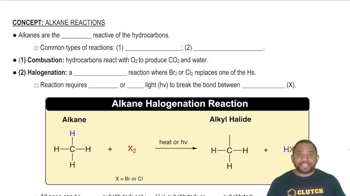Ch.22 - Chemistry of the Nonmetals

Brown15th EditionChemistry: The Central ScienceISBN: 9780137542970Not the one you use?Change textbook
Chapter 22, Problem 65
Complete the exercises below. Complete and balance the following equations: e. Ca(CN)₂ (s) + HBr (aq) → ?
 Verified step by step guidance
Verified step by step guidance1
Identify the reactants and products: The reactants are calcium cyanide, Ca(CN)_2, and hydrobromic acid, HBr. The products will be calcium bromide, CaBr_2, and hydrogen cyanide, HCN.
Write the unbalanced chemical equation: Ca(CN)_2 (s) + HBr (aq) → CaBr_2 (aq) + HCN (g).
Balance the equation by adjusting coefficients: Start by balancing the calcium (Ca) atoms. There is 1 Ca atom on both sides, so they are balanced.
Balance the cyanide (CN) groups: There are 2 CN groups in Ca(CN)_2, so you need 2 HCN molecules on the product side. Adjust the equation to: Ca(CN)_2 (s) + HBr (aq) → CaBr_2 (aq) + 2 HCN (g).
Balance the bromine (Br) atoms: There are 2 Br atoms in CaBr_2, so you need 2 HBr molecules on the reactant side. The balanced equation is: Ca(CN)_2 (s) + 2 HBr (aq) → CaBr_2 (aq) + 2 HCN (g).
Key Concepts
Here are the essential concepts you must grasp in order to answer the question correctly.
Balancing Chemical Equations
Balancing chemical equations is essential to ensure that the law of conservation of mass is upheld, meaning the number of atoms of each element must be the same on both sides of the equation. This involves adjusting coefficients in front of compounds to achieve balance, reflecting the stoichiometry of the reaction.
Recommended video:
Guided course

Balancing Chemical Equations
Types of Chemical Reactions
Understanding the types of chemical reactions, such as double displacement reactions, is crucial for predicting the products of a reaction. In this case, calcium cyanide (Ca(CN)₂) reacts with hydrobromic acid (HBr), leading to the formation of new compounds through the exchange of ions.
Recommended video:
Guided course

Common Types of Alkane Reactions
Solubility Rules
Solubility rules help determine whether a compound will dissolve in water or precipitate out of solution. In this reaction, knowing that calcium bromide (CaBr₂) is soluble while calcium cyanide may form a precipitate can guide the prediction of the products and the overall reaction behavior.
Recommended video:
Guided course

Solubility Rules
Related Practice
